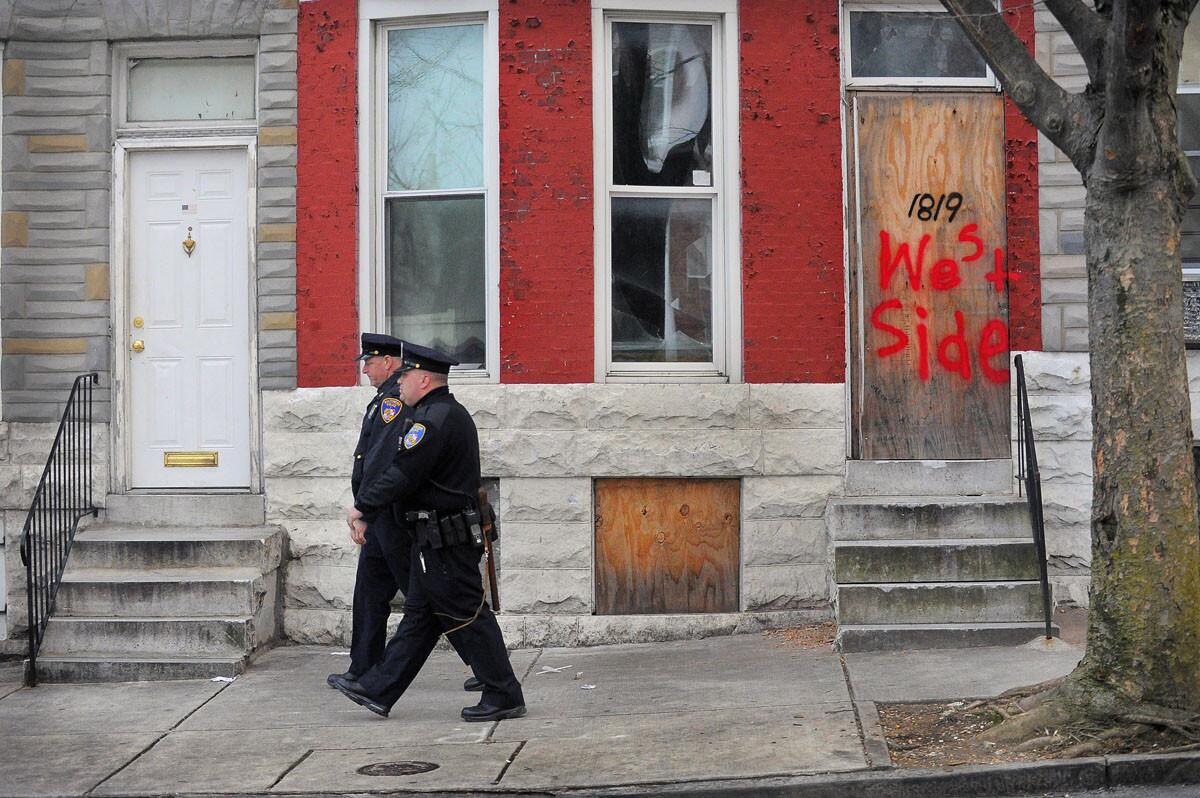‘The Wire’ in real life: the Baltimore neighborhood Freddie Gray called home

- Share via
The images of burning cars and smashed shop windows during riots this week on the edgy streets of West Baltimore were probably familiar to anyone who ever watched the HBO TV series “The Wire,” which chronicled the hard life and tense times of many in this American city.
The incendiary device this time was the death April 19 of a 25-year-old black man, Freddie Gray, whose spine was severed sometime after he was arrested following a police chase on foot.
But the vociferous street protests come out of a long history of trouble and poverty faced by many Baltimore residents--especially those in the impoverished neighborhoods of Sandtown-Winchester/Harlem Park in West Baltimore which Gray called home.
Here, a lifetime away from the museums, upscale restaurants and charter boat tours of Baltimore’s tourist-friendly Inner Harbor area, is both the history and the present-day reality of a sobering number of Baltimore residents.
Consider the following:
-- Baltimore has the nation’s fifth-highest murder rate, according to the FBI’s Uniform Crime Reports for 2013, behind Detroit; New Orleans; Newark, N.J.; and St. Louis.
-- In April 1968, riots broke out after the assassination of Martin Luther King Jr. Six people died, 700 were injured and 5,800 arrests were made. The National Guard and the U.S. Army’s 82nd Airborne Division were dispatched to deal with 1,200 fires and more than 1,000 looted or damaged businesses.
-- Baltimore is 63% black. The Sandtown-Winchester/Harlem Park neighborhood is 97% black. The neighborhood’s violent crime rate is 23 per 1,000 residents, according to a recent study by the progressive Justice Policy Institute--nearly double the rate for the city as a whole, and almost six times the U.S. rate overall.
-- The West Baltimore depicted in “The Wire” was a network of neighborhoods plagued by drugs, poverty and violent crime as police and young blacks clashed on the streets. The series concluded in 2008--but Sandtown-Winchester/Harlem Park is still a cauldron of poverty, crime, drugs and social pathology.
-- Young blacks in this part of the city are nearly as likely to be arrested as they are to finish high school. One of every four juveniles here was arrested between 2005 and 2009, according to a 2011 Baltimore City Health Department report. The neighborhood’s juvenile arrest rate was 252 per 1,000 residents, nearly double the rest of the city.
-- Sandtown-Winchester/Harlem Park is the city’s “highest incarceration community”--it has more people in state prisons than any Baltimore neighborhood, the Justice Policy Institute report found. With a population of 14,000, Sandtown-Winchester/Harlem Park has 458 people in state prison, the report said, the vast majority of them African-Americans.
-- Only 25% of adults over 25 in Sandtown-Winchester/Harlem Park have a high school diploma (although the Justice Policy Institute report found that 66% had either a high school diploma or a GED, an indication that some earned their credentials in prison). Half the neighborhood’s high school students were listed as chronically absent in 2012.
-- The neighborhood’s homicide rate was more than double that of Baltimore overall between 2005 and 2009, according to the health department, and while the crime rate has started to decline, the biggest problem remains narcotics offenses. Most of those arrested are black men.
-- Unemployment among those aged 16 to 64 in Sandtown-Winchester/Harlem Park was at 52% in 2012, according to the Justice Policy Institute report. The median household income in 2010 was $22,000, versus $37,000 for Baltimore overall, according to the health department report.
-- More than a third of households in Sandtown-Winchester/Harlem Park are headed by a single parent, versus a quarter for Baltimore. The percent of the neighborhood’s families living below the federal poverty line is double that of Baltimore, 30% versus 15%.
-- In Sandtown-Winchester/Harlem Park, more than 7% of children under 6 had elevated levels of lead in their blood in 2012, the Justice Policy Institute report found. According to a lawsuit filed by Gray’s family in 2008, blood tests on Gray and his two sisters between 1992 and 1996 showed lead levels above those defined by state law as the threshold for lead poisoning.
Follow @davidzucchino on Twitter
More to Read
Sign up for Essential California
The most important California stories and recommendations in your inbox every morning.
You may occasionally receive promotional content from the Los Angeles Times.















